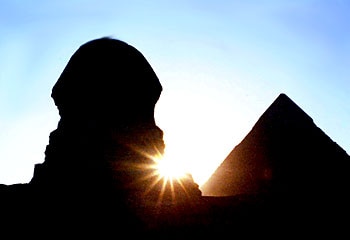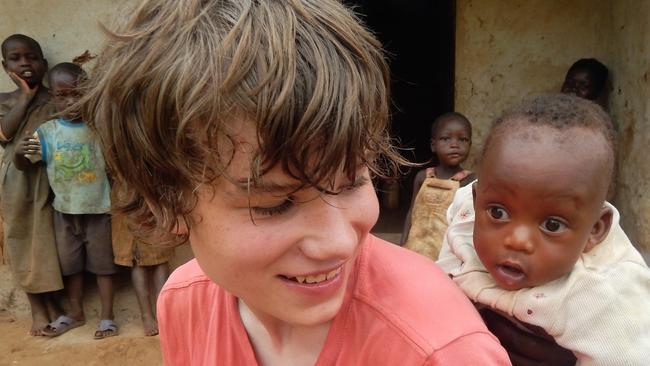Fun with the Egyptian sun
LEIGH Dayton and the Egyptian president gather in the desert with 14,000 astronomy geeks to watch a total eclipse of the sun.

NEAR Sallum: talk about good timing. The moon's just taken its first bite out of the sun and here comes Egyptian President Hosni Mubarak's entourage, all sleek cars, flapping flags and one aristocratically waving hand. I wave back.
It's 11.20am. Mubarak, 14,000 astronomy geeks and I have gathered in the Egyptian desert to watch a total eclipse of the sun. We are here, not far from the Libyan border, because the pros say that's where we'll get nearly five minutes of totality. That's the, well, total time that the moon fully covers the face of the sun when all three bodies line up, one behind the other.
Evidently, totality doesn't get much longer than this. My British astronomer friends Heather Couper and Nigel Henbest – collectively known as Hencoup – say this will be one of the best in a decade. That's why they've signed on as celebrity astronomers for this two-week eclipse tour of Egypt, and I'm along for the ride.
It seemed a great idea. I would see my first eclipse and take in the sights with friends. I never guessed we three would join two busloads of 63 eclipse fanatics (and I do mean fanatics). Last evening, when our companions learned access to the viewing site would be closed for security purposes at 7.30 this morning, there was mass hysteria. "We must leave at once," they demanded. So, armed with pillows and blankets borrowed from our genteelly faded resort outside the coastal town of Marsa Matruh, we set out on the 220km drive through the starry Egyptian night to Sallum. "Nutters," I grumble, and turn up the volume on my iPod.
Fortunately, Mubarak and company know how to throw a party. We arrive in the wee hours to a specially built encampment in the middle of nowhere. It's huge, consisting of 20 enormous tents, each with a toilet, a canteen and its own area designation. Soon I wrap myself in my blanket and fall asleep on thick oriental carpets while the fanatics lounge on gilt-edged upholstered chairs, talking eclipse talk. I sleep soundly, missing a visit by the sniffer dogs.
Security sweep? It turns out that thanks to Hencoup's star status – they do television and radio, as well as books and magazines – we are in the celebrity tent, right next to Mubarak's. What's more, we learn that Charles and Camilla may drop in. Talk about a stellar event.
* * *
BACK to Day One: Hencoup and I meet our companions and our guides, two tall, gorgeous Egyptologists, Nerma and Dalia. Unlike the flustered staff of our overbooked resort, the pair, cousins, get us organised and on the road in record time. Our first stop is the Egyptian Museum, just across the Nile in downtown Cairo. The crowds are enormous. It's elbow to elbow. Dalia struggles to be heard as we try to glimpse the museum's treasures. The King Tut gallery is claustrophobic. "I've never seen it like this," sighs Dalia.
It's the eclipse. Everyone has arrived the same day and is heading en masse to the same hot spots. This also explains the confusion at our resort which lands me in the night manager's far-from-salubrious room. He asks if I would like to share. "Only for a mega-upgrade," I reply, grabbing the insect spray as I show him the door.
It's also a crush back in Giza, where the pyramids and the Sphinx sit solemnly, oblivious to the crowds of gnat-sized bipeds below. We're so rushed and crushed that Hencoup and I decide to return post-eclipse, and when we do, it's so worth it.
They may be trite. They may be touristy, but wow. It gives us goose bumps to climb up the side of the Great Pyramid, then traverse the narrow passageway to the more than 4000-year-old burial chamber of Khufu, aka Cheops. To gather our composure, Hencoup and I sit on a stone ledge, part way up the amazing structure, sending text messages.
We wonder whether texting is the pinnacle of four millennia of human endeavour.
Nearby is the Sphinx. Carved about 2500BC, it stands 20m high and is one helluva hunk of rock. See it and ponder its riddle. "What goes first on four legs, then two, then three and finally four?" A texting human, of course. We're awed. Absolutely.
I return, post-eclipse, to the Egyptian Museum and it is also superb when devoid of rampaging eclipsers. Since the Hencoup pair has by now returned to Britain, I'm on my own, wandering among the 120,000 objects on display. They range from the humble to the grand and represent every period of Egyptian history, from the so-called Narmer Palette, dating to 3100BC, up to Greco-Roman times in the second century AD.
By the way, Dalia did her doctoral research in the latter period, supervised by none other than the world's most famous Egyptologist, Zahi Hawass. He's the director of Egypt's Supreme Council of Antiquities. She's his protegee. (Mark my words, when Hawass eventually retires, Dalia Wassim has the job.) But back to the museum. It's wonderful. Unlike many Western museums, there's not a single interactive display. Nobody's trying to make the 143-year-old museum contemporary. It's all exquisite objects with small, individually hand-typed labels. I love it and I am obviously not alone: tourists mingle with noisy school groups, giggling teenagers and local professionals who have dropped in for a spot of Pharaonic history. I text Hencoup: "Wish you were here."
* * *
UP the Nile: I have a friend who spent years as a journalist with National Geographic. He tells of his two favourite experiences. In one, he's on a balcony overlooking Sydney's Taronga Zoo in the early evening. The animals call, the breeze rustles the scented eucalypts and the city lights wink on. In the other, he's cruising up the Nile.
I've done the first and am enjoying the second aboard a comfortable cruise ship, the Princess Sarah. Just a few eclipsers remain, thank goodness. As we cruise northwards, Bill, a retired geologist from San Francisco, explains the forces of nature that shaped the Valley of the Kings and the nearby Valley of the Queens. We marvel that tombs carved into the hills thousands of years ago are youngsters in comparison with the rocks.
What we don't see is a contemporary threat to archeological treasures along the Nile, especially those near Luxor, the city built on ancient Thebes, capital of Egypt's New Kingdom (1550BC-1069BC) and site of the vast and interconnected Karnak and Luxor temples. No, we're not talking flooding from the Aswan High Dam, completed in 1971. That project necessitated the relocation of monuments such as the Great Temple of Abu Simbel with its four colossal statues of Ramses II, and the exquisite little Temple of Isis at Philae near Aswan.
We're talking Luxor's broad-scale agriculture and leaky sewers. Together, they've raised the water table by several metres, despite Hawass's efforts. "When I found out that the Temple of Luxor and the Temple of Karnak were going to completely fall apart because of the rising water table, I was shocked," he lamented earlier this year.
I don't tell Bill about the sewers. Besides, I'd rather think about Hatshepsut's Temple. Like so many fabled places – the valleys of the Kings and Queens, the Colossi of Memnon and the temple of Karnak – it's a scarab's throw from the centre of Luxor.
While exploring the rock-hewn mortuary temple, I meet an Egyptologist from the University of North Carolina. He's doing a GPS mapping survey of the area and in just five months has pinpointed 700 tombs. Some, such as a newly discovered cache tomb near King Tut's resting place in the Valley of the Kings, have yet to be fully excavated.
Dalia and Hawass are now working at the tomb, designated KV63, which may contain as many as eight mummies. Better still, one of them may be that of the legendary beauty Queen Nefertiti, who lived in the mid-1300s. That's BC, of course.
I sigh. It's all better than I dreamed. In the Valley of the Kings, tomb paintings remain vibrant and tell stories so real that I ache in sympathy. The artistry is superb and the symbols are laden with meaning, obvious even to modern visitors.
Egypt is definitely worth the marathon flight and even the company of obsessed eclipsers. Oh yes, the eclipse. Let me put it this way. A diamond ring of white light has just blazed around a malevolent black hole in space where the sun once shone. The temperature has plummeted. I shiver while little tears trickle down my cheeks. I'm hooked. I'm a crazed eclipser, too.
Leigh Dayton is The Australian's science writer.



